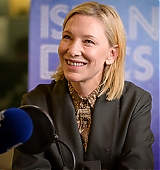Happy Sunday, everyone!
You can now listen to Desert Island Disc episode with Cate Blanchett where she shared some tracks and book she will take if cast away on a desert island.
Tracks that Cate Blanchett chose:
- Mahler: Symphony No. 5 in C-Sharp Minor II – Gustav Mahler
- Bésame Mucho – Los Panchos
- Tannhäuser: Pilgrims’ Chorus – Richard Wagner
- Go Tell the Women – Grinderman
- Proof – I Am Kloot
- Blow the Wind Southerly – Kathleen Ferrier
- The Little Weaver Bird – Molly Drake
- Lil’ Darlin’ – Count Basie


Seven things we learned from Cate Blanchett’s Desert Island Discs
1. Music is important to her – and helps when she’s preparing to take on a new role
“It’s often the starting point to me,” explains Cate, “when I’m thinking about a role or an atmosphere that you’re stepping into as an actor, because it obviously bypasses language. It’s a conduit for memory and non-linear connections, or strange left of field associations you might give birth to when you’re thinking about a role.”
She also admits that listening purely for pleasure hasn’t always been easy for her: “I think in the last 15 years, the constant cacophony of being a mother of four children [meant that] music had left my life a little bit and had been associated with work. And now that they’re locking themselves in their rooms and talking to their girlfriends, it’s come back into my life.”
Her most recent role is playing the conductor of a German orchestra in Todd Field’s film Tár: “Standing in front of the Dresden Philharmonic playing Mahler, [music] powerfully re-entered my life.”
She has chosen the second movement of Mahler’s Fifth Symphony, played by the Berlin Philharmonic conducted by Claudio Abbado, as her first desert island disc .
2. A much-loved song in Spanish reminds her of her father
Cate’s second track is Bésame Mucho (meaning ‘kiss me a lot’), written in 1940 by songwriter Consuelo Velázquez. Cate has chosen a much-loved version by Trio Los Panchos:
“This was on an album that my dad had and it was played a lot and I would always put it on and think of him. He grew up near the border of Mexico… [He] had a rather rough childhood on the streets of various towns in Texas. His was a childhood of neglect.”
She also recalls how a nautical mishap led to her parents’ first meeting: “[Dad] was in the US Navy… and his ship broke down in Melbourne [where] my mother was a teacher. She went down to the port with some friends to find some men to come to their teachers’ dance. And he happened to be one of them, and they danced all night. They corresponded for a couple of years and then he came back to Australia, and they decided to get hitched!”
3. Her relationship with music changed completely after her father’s sudden death
Cate was just 10 years old when her father died from a heart attack at the age of 41.
“There was a lot of dancing in my house, a lot of music actually, but it became quite silent after my dad died,” remembers Cate.
“I actually remembered the last time I saw him. I was playing the piano and he was going off to work – he was in advertising – and I waved goodbye and I stayed at the piano and then we went out to see the Muppet Movie – I loved the Muppets.”
“And then before the Muppet Movie came on, it flashed on the bottom of the screen: ‘Could Mrs. Blanchett please come and see the manager?’ and she did. I realised later that day that my father had had a fatal heart attack.”
Cate doesn’t remember playing the piano again after that.
“I just didn’t go back to it,” says Cate, “and I wonder now as I put myself on the couch, I wonder if it was because I associated it with the guilt of not getting up from the piano and kissing him goodbye?”
“Strangely, I didn’t think about it until I had actually sat down at the piano – my husband bought me a piano for my 50th birthday – and I went: ‘I’m going to play again,’ and suddenly all of these memories come flooding back.”
4. She much preferred singing to acting when she was at school
“All the parts in the school plays that were organised by the teachers went to the girls that were really confident, popular and good at sport,” laughs Cate, adding: “And I was not that!”
She was only cast in minor roles: “I was a statue in the Chronicles of Narnia… I was in white Lycra which no one looks good in, particularly as an adolescent girl. The stage manager cued us late and so I was climbing up on the rostrum – I had this beautiful pose planned – and I didn’t have time to turn around so all the audience saw was my bum!”
“I think probably the most important creative outlet for me was when I finally got up the courage to audition for the choir. The music school was massive at my school and there was a choir of probably about 140 girls.”
“This formidable hurricane of a musician Jane Elton Brown, absolutely terrifying round the music school, conducted the choir. I auditioned for her so she played arpeggios and started down low and she looked at me. She kept going up higher and she stopped. She took off her glasses and said, ‘You have a three octave range, girl!’ And so I got into the choir.”
“I think it was the place where I realised the power of the ensemble, that you were making music together. So when we sang in an unaccompanied way, it was really electrifying.”
Cate’s third desert island disc takes her back to a concert with the school choir – “in a hideous blue dress” – at the Melbourne Festival Hall. “I think it was one of the most transporting experiences of my life. Every time I listen to it, I weep with joy!”
Her choice is the Pilgrims’ Chorus from Tannhäuser by Richard Wagner.
5. Her first job with a casting agent gave her a great insight into how the industry works
After graduating from the National Institute of Dramatic Arts in Sydney, Cate didn’t immediately find work as an actor. Instead she accepted a job with Liz Mullinar, a leading Australian casting agent at the time. Cate was employed as a reader: when actors came in to audition, she would read the other lines in the scene – and watching dozens of actors trying to win parts made a big impression on her.
“It was extraordinary from an anthropological perspective, but also from a work perspective. You realised the energy, the way people walked into the room, whether they’d got the job or not. But I also realised when they left the room that whether you got the job or not wasn’t entirely dependent upon what you’d done. It wasn’t personal.”
“It was really liberating, and I think it allowed me to have a bit more devil-may-care attitude when in fact I eventually got an audition myself.”
6. Royal handwriting helped her to prepare for her breakthrough role
Cate first reached a global audience in the 1998 film Elizabeth: she played the title role, and won an Oscar nomination and a BAFTA. She recalls how her research for the part included a trip to the British Library, to see letters written by Elizabeth I.
“There were many examples of her handwriting – and watching her handwriting change from the letter that she wrote to her brother, to beg for her life when she was imprisoned, to a document she was writing to a French ambassador, which was very late in her life, and watching the handwriting become increasingly shaky, I understood something that I can’t even put into words… the length of her reign [44 years], the amount of personal sacrifice that she’d had to make and everything that had gone on under her when she was on the throne.”
7. Her portrayal of Bob Dylan was improved by one simple piece of advice
In 2007 Cate was one of the many actors taking on the role of Bob Dylan in Todd Haynes’s distinctly unconventional biopic of the singer-songwriter.
“I played him at the time when he went electric, when he was really giving the finger to the audience and saying, ‘I’m not a folk singer’.”
“But playing a man… was it a man or was it a sort of a musical force? You realise that in that particular film the character was made up of many different parts.”
“A friend of mine who’s a make-up artist said to me a few days into the shoot: ‘Put a sock down your pants!’ I said: ‘What?!’ She said: ‘You’re on the bed, put a sock down your pants,’ and I said, ‘Oh, OK’ and I did! And I didn’t look back. It absolutely helped,” laughs Cate.
Source: BBC





 A Manual for Cleaning Women (202?)
A Manual for Cleaning Women (202?) Father Mother Brother Sister (2025)
Father Mother Brother Sister (2025)  Black Bag (2025)
Black Bag (2025)  The Seagull (2025)
The Seagull (2025) Bozo Over Roses (2025)
Bozo Over Roses (2025) Disclaimer (2024)
Disclaimer (2024)  Rumours (2024)
Rumours (2024)  Borderlands (2024)
Borderlands (2024)  The New Boy (2023)
The New Boy (2023) 












It is very important for me to hear new things about Cate’s life to better understand who she is. I am happy that he has rediscovered the relationship with music because for me it is the most beautiful thing that exists. You are never alone if you have music, every note can make you remember and relive emotions that you have experienced until they become part of you.